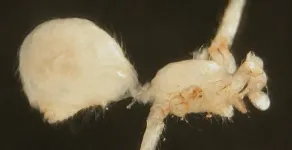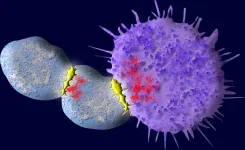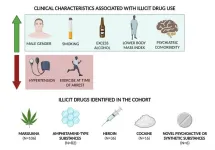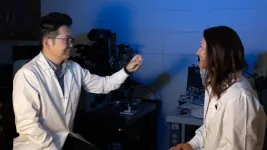(Press-News.org) PHILADELPHIA – A gene encoding a protein linked to tau production—tripartite motif protein 11 (TRIM11)—was found to suppress deterioration in small animal models of neurodegenerative diseases similar to Alzheimer’s disease (AD), while improving cognitive and motor abilities, according to new research from the Perelman School of Medicine at the University of Pennsylvania. Additionally, TRIM11 was identified as playing a key role in removing the protein tangles that cause neurodegenerative diseases, like AD. The findings are published today in Science.
AD is the most common cause of dementia in older adults, with an estimated 6 million Americans currently living with the disease. It is a progressive brain disorder that slowly destroys memory and thinking skills. Foundational research at Penn Medicine led by Virginia M.Y. Lee, PhD, the John H. Ware III Professor in Alzheimer’s Research in Pathology and Laboratory Medicine, and the late John Q. Trojanowski, MD, PhD, a former professor of Geriatric Medicine and Gerontology in Pathology and Laboratory Medicine, reveals that one of the underlying causes of neurodegenerative diseases is neurofibrillary tangles (NFTs) of tau proteins, which cause the death of neurons, leading to the symptoms of AD, like loss of memory.
In addition to AD, aggregation of tau proteins into NFTs is associated with over 20 other dementias and movement disorders including progressive supranuclear palsy, Pick’s disease, and chronic traumatic encephalopathy, collectively known as tauopathies. Nevertheless, how and why tau proteins clump together and form the fibrillar aggregates that make up NFTs in patients with these diseases remains unclear. This major gap in knowledge has made the development of effective therapies challenging for researchers.
“Most organisms have protein quality control systems that remove defective proteins, and prevent the mis-folding and accumulation of tangles—like the ones we see with tau proteins in the brain of those with taupathies— but until now we didn’t know how this works in humans, or why it malfunctions in some individuals and not others,” said senior author, Xiaolu Yang, PhD, a professor of Cancer Biology at Penn. “For the first time, we have identified the gene that oversees tau function, and have a promising target for developing treatments to prevent and slow the progression of Alzheimer’s disease and other related disorders.”
Yang and his team, including first author Zi-Yang Zhang, PhD, a postdoctoral researcher in Yang’s lab, previously found that TRIM proteins play an important role in protein quality control in animal cells. After examining over 70 human TRIMs, they found that TRIM11 has a major role in suppressing tau aggregation. TRIM11 possesses three main functions related to the quality control of tau proteins. First, it binds to tau proteins, especially the mutant variants that cause disease, and helps eliminate them. Second, it acts as a “chaperone” for tau, preventing the proteins from mis-folding. Finally, TRIM11 dissolves pre-existing tau aggregates.
Using postmortem brain tissues of 23 individuals with AD and 14 health controls from the Center for Neurodegenerative Disease Research tissue bank—created and maintained by Lee and Trojanowski—researchers validated these findings, and found that levels of TRIM11 protein are substantially reduced in the brains of individuals with AD, compared to healthy control individuals.
To determine the potential utility of TRIM11 as a therapeutic agent, researchers used adeno-associated viral vector (AAV), a tool commonly used in gene therapy, to deliver the TRIM11 gene into the brain of multiple mouse models. Researchers found that mice with tau pathologies receiving the TRIM11 gene exhibited a marked decrease in the development and accumulation of NFTs, and had much improved cognitive and motor abilities.
“Not only do these findings tell us that TRIM11 could play an important role in protecting people from Alzheimer’s and similar diseases, but we also see that we might be able to develop future therapies that replenish TRIM11 in individuals with lower levels,” said Yang. “We are eager to work with our colleagues to explore the possibility of developing gene therapies that halt the progression of neurodegenerative disease.”
This study was supported by the National Institutes of Health (R01CA243520, UL1TR000003) and funding received by Penn under a sponsored research agreement with Wealth Strategy Holding Limited.
Editor’s note: Yang is an inventor on patents and patent applications owned by the University of Pennsylvania related to TRIM proteins, and is a co-founder and equity holder of Evergreen Therapeutics LLC, which received investments from Wealth Strategy Holding Limited. Penn and Yang have either received, or may receive in the future, financial consideration related to the licensing of certain Penn intellectual property to Evergreen Therapeutics LLC.
###
Penn Medicine is one of the world’s leading academic medical centers, dedicated to the related missions of medical education, biomedical research, excellence in patient care, and community service. The organization consists of the University of Pennsylvania Health System and Penn’s Raymond and Ruth Perelman School of Medicine, founded in 1765 as the nation’s first medical school.
The Perelman School of Medicine is consistently among the nation's top recipients of funding from the National Institutes of Health, with $550 million awarded in the 2022 fiscal year. Home to a proud history of “firsts” in medicine, Penn Medicine teams have pioneered discoveries and innovations that have shaped modern medicine, including recent breakthroughs such as CAR T cell therapy for cancer and the mRNA technology used in COVID-19 vaccines.
The University of Pennsylvania Health System’s patient care facilities stretch from the Susquehanna River in Pennsylvania to the New Jersey shore. These include the Hospital of the University of Pennsylvania, Penn Presbyterian Medical Center, Chester County Hospital, Lancaster General Health, Penn Medicine Princeton Health, and Pennsylvania Hospital—the nation’s first hospital, founded in 1751. Additional facilities and enterprises include Good Shepherd Penn Partners, Penn Medicine at Home, Lancaster Behavioral Health Hospital, and Princeton House Behavioral Health, among others.
Penn Medicine is an $11.1 billion enterprise powered by more than 49,000 talented faculty and staff.
END
Cognitive and computer scientists at the University of Toronto, Universitat Pompeu Fabra and the Catalan Institution for Research and Advanced Studies have found child language development and the historical evolution of the world’s languages share a common cognitive foundation—a core knowledge base where patterns of children’s language innovation can predict patterns of language evolution, and vice versa.
Published today in Science, the paper is a first-of-its-kind step toward a unified theory of the lexicon and the mind examined across timescales. The result may also help predict how a word’s meaning may change ...
People often debate whether social media creates "echo chambers" by showing users content that matches their politics and in turn increases polarization. A new study published today in the journal Nature reports that reducing Facebook users' exposure to content from politically "like-minded" sources had no measurable effect on their political beliefs or attitudes during the 2020 U.S. presidential election.
The findings are part of a broader research project examining the role of ...
Australia’s rich and diverse fauna never fails to surprise us, as a new spider species has been documented from the continent.
The novel species, a blind daddy long-legs, was found in boreholes in the arid Pilbara of Western Australia. It is the first cave-adapted daddy long-legs spider reported from the continent, with other blind species of its genus so far only found in Thailand, Laos, and Vietnam.
“It represents a subfamily that was previously thought to be restricted to the tropical north and east of the continent,” says Bernhard Huber, one of the authors of a recent study published ...
27 July 2023
Geological Society of America
Release No. 23-28
Contact: Justin Samuel
+1-303-357-1026
jsamuel@geosociety.org
Boulder, Colo., USA: GSA is pleased to welcome three exceptional new Fellows who will join us in our mission to advance geoscience knowledge and discovery through excellent writing, research, and advocacy.
GSA’s 2023–2024 Science Communication Fellow is Arianna Soldati.
Soldati is an assistant professor of volcanology at North Carolina State University. Her lab group works on a variety of topics, ranging from effusive eruptions to critical minerals. She received her Ph.D. in geological sciences from the University of ...
New Haven, Conn. — In a promising form of immunotherapy known as CAR T-cell (chimeric antigen receptor) therapy, the patient’s T cells are engineered to better recognize and attack antigens on the surface of cancer cells. In treatments currently approved for use in battling lymphoma and leukemia, however, the therapy has a drawback: Amidst the cancer-killing frenzy, many engineered T cells become tainted with the remnants of cancer antigens, which causes them to turn on other T cells. This eventually depletes the body of cancer-fighting cells ...
Digital Science, a technology company serving stakeholders across the research ecosystem, is pleased to announce that the Research Corporation for Science Advancement (RCSA) has chosen Symplectic Grant Tracker from Digital Science’s suite of flagship products to advance its aims of providing catalytic funding for innovative scientific research and the development of academic scientists.
RCSA joins the 50+ foundations, charities and funders worldwide who manage their end-to-end grant lifecycle using Symplectic Grant Tracker. Designed from the outset to meet research funding needs, Grant Tracker includes features to assist applicants, reviewers, committees and ...
PHILADELPHIA (July 27, 2023) – Two decades ago, the Practice Environment Scale of the Nursing Work Index was published to measure the nursing practice environment. Although the instrument's use has resulted in advances in science and quality improvement efforts, its potential may be limited by the availability and quality of translations into different languages.
Researchers from the University of Pennsylvania School of Nursing (Penn Nursing) investigated published translations of the instrument and have identified ...
Philadelphia, July 27, 2023 – Approximately one-third of young adults in Victoria, Australia, who experienced sudden cardiac deaths (SCDs) outside of a hospital setting from April 2019 to April 2021 used illegal drugs prior to their fatal events, reports a new study in Heart Rhythm, the official journal of the Heart Rhythm Society, the Cardiac Electrophysiology Society, and the Pediatric & Congenital Electrophysiology Society, published by Elsevier. The analysis of data on substance abuse, revealed through positive toxicology reports and patient histories and recorded in one of the world’s largest and most comprehensive SCD registries, ...
In a new study funded by a $3 million grant from the National Institutes of Health (NIH), University of Missouri researcher Kiho Lee, an associate professor in the College of Agriculture, Food and Natural Resources, will use gene editing to investigate the building blocks of disease. His ultimate goal — to discover clinically significant explanations for human diseases like Alzheimer’s, cancer and infertility, while working on solutions to global food insecurity.
Common diseases, such as Alzheimer’s, are widespread in humans, plaguing an estimated 11% or 6.7 million Americans over age 65, according to The ...
Spiders are often maligned for being creepy critters, but they are some of the most environmentally friendly pest regulators. Because they actively feed on flies, moths, mosquitoes and roaches, spiders eliminate parasites and many other vectors of disease—protecting both humans and plants from harm.
A new University of Maryland-led study published online in the journal Ecology found one simple way to take advantage of this natural ecosystem service: give tree-dwelling spiders a more diverse habitat.
“We found that there’s ...







